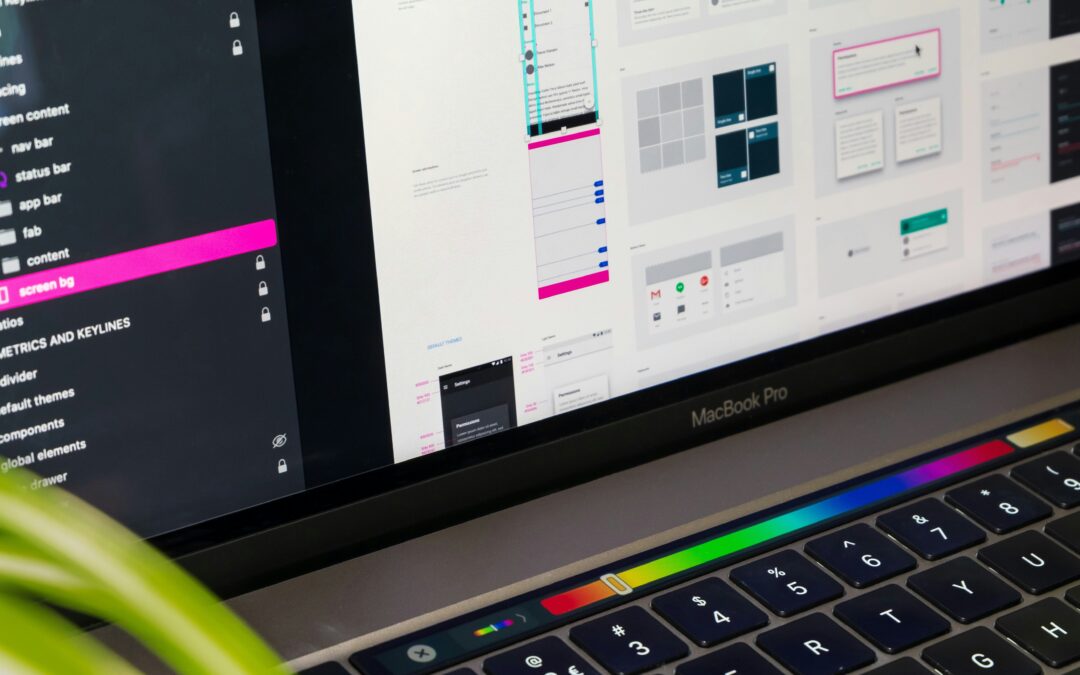The world of user experience design is evolving rapidly. In 2024, companies will be faced with the challenge of finding innovative solutions to improve the User friendliness of their digital products. A well-designed user experience is crucial for success in the digital world.
UX design goes far beyond an appealing look. It encompasses the entire interaction between user and product. The aim is to create intuitive and effective solutions that meet the needs of the user. The User Experience Trends 2024 show that personalized experiences and seamless integration of different channels are becoming increasingly important.
Companies must be able to react flexibly to changing market conditions. An adaptable IT infrastructure forms the basis for modern UX concepts. It enables new technologies to be integrated quickly and the User experience continuously improve.
Key findings
- UX design is crucial for business success
- Personalization becomes the standard
- Flexible IT systems enable better user experiences
- Cross-channel strategies are gaining in importance
- New technologies such as AR and VR influence UX design
The importance of UX design for business success
UX design plays a decisive role in the success of companies. It has a significant influence on customer satisfaction, conversion rates and competitiveness. A well thought-out UI design and Interaction design the Customer loyalty sustainably.
Increase in customer satisfaction
User-friendly interfaces and intuitive navigation structures increase user satisfaction. A well thought out UI design reduces frustration and promotes positive experiences. This leads to a stronger Customer loyalty and increases the likelihood of recommendations.
Improvement in conversion rates
An optimized Interaction design can significantly increase conversion rates. Clear call-to-actions, smooth checkout processes and confidence-building elements motivate users to buy. Companies such as Amazon have significantly increased their sales through continuous UX optimization.
Creation of competitive advantages
Outstanding UX design differentiates companies from the competition. Apple and Airbnb are examples of companies that have become market leaders through innovative user experiences. A well thought out UI design can bind customers to a brand in the long term and thus create a sustainable competitive advantage.
"Good design is good business." - Thomas Watson Jr., former CEO of IBM
Flexible IT system landscapes as the basis for modern UX
Modernity IT systems form the backbone of an excellent User Experience. They enable companies to react flexibly to market changes and implement customer requirements quickly.
The Scalability of IT systems plays a decisive role. It allows resources to be adapted as required and new functions to be integrated seamlessly. This ensures a smooth user experience, even with increasing user numbers or more complex requirements.
Adaptability is another key factor. Flexible IT landscapes make it possible to implement innovative UX concepts quickly. They support the continuous improvement of the user experience and thus promote customer satisfaction.
- Rapid integration of new technologies
- Optimized use of resources
- Improved responsiveness to market trends
Companies that invest in flexible IT systems create the basis for future-proof digital experiences. They remain competitive and can inspire their customers with innovative solutions.
Cross-channel customer experience strategies
In the digital era, a seamless Omnichannel-strategy is crucial to the company's success. The integration of different channels makes it possible to reach customers across their entire Customer Journey optimally.
Integration of online stores and mobile apps
The linking of online stores with mobile apps is a core element of modern Channel integration. Today's customers expect a consistent shopping experience, regardless of whether they are shopping on their desktop or smartphone. One successful example is the ability to save and continue shopping baskets across devices.
Challenges in linking communication channels
The Channel integration involves technical and organizational hurdles. Data silos need to be broken down and systems need to be connected. Orchestrating uniform communication across all touchpoints also requires close coordination between departments.
Holistic approach for optimal customer experiences
A holistic approach to customer experience is indispensable across all industries. It includes the analysis of the entire Customer Journeyidentifying pain points and continuously optimizing all points of contact. This is the only way for companies to offer consistent and personalized experiences across all channels and differentiate themselves from the competition.
"The Omnichannel-strategy is the key to Customer loyalty in an increasingly networked world."
Personalization and tailored user experiences
In today's digital world Personalization plays a central role in successful customer experiences. Through targeted User analysis companies can offer customized content and functions that are precisely tailored to individual needs.
The basis for effective Personalization forms a thorough User analysis. Tools like Google Analytics provide valuable data about the behavior and preferences of visitors. These findings flow into the development of personalized user experiences.
Recommendation algorithms play a key role in personalization. They analyze user behavior and suggest suitable products or content. A well-known example is the "Customers who bought this item also bought..." section in online stores.
"Personalization is the key to an improved customer experience and greater customer loyalty."
To illustrate the benefits of personalization, let's look at some key figures:
| Metrics | Improvement through personalization |
|---|---|
| Conversion rate | +20% |
| Average order value | +15% |
| Customer satisfaction | +25% |
These figures are an impressive demonstration of how personalization and targeted User analysis can increase the effectiveness of digital offerings. It is becoming increasingly important for companies to invest in these technologies in order to remain competitive and retain customers in the long term.
User experience trends 2024
The world of User friendliness is constantly evolving. Exciting trends are emerging for 2024 that will revolutionize the digital experience.
Mobile UX design
The Mobile-First-approach is becoming increasingly important. Websites and apps must be optimized for smartphones in order to offer users a seamless experience. Responsive designswhich automatically adapt to different screen sizes are becoming standard.
Voice-driven UX design
Voice user interfaces are revolutionizing the way we interact with devices. Voice assistants are becoming more intelligent and natural in their communication. Designers need to develop user interfaces that are both visually and acoustically appealing.
Augmented reality (AR) and virtual reality (VR)
Immersive technologies open up new dimensions of interaction. AR apps make it possible to integrate virtual elements into the real world. VR experiences immerse users in completely digital worlds. These technologies are used in areas such as retail, education and entertainment.
| Trend | Main feature | Application example |
|---|---|---|
| Mobile-First | Optimization for smartphones | Responsive e-commerce platforms |
| Voice User Interface | Voice-controlled interaction | Smart home control by voice |
| Immersive technologies | AR and VR integration | Virtual product presentations |
These trends will shape the future of UX design. Companies that focus on these developments at an early stage can secure a decisive competitive advantage and offer their users innovative, appealing experiences.
Dark mode designs: advantages and implementation

The Dark Mode is taking the digital world by storm. This trend not only offers a stylish look, but also practical benefits for users. The Eye friendliness is the top priority. In low light or at night, the dark mode is easy on the eyes and reduces strain.
Another plus point is the improved Battery life. Especially with OLED displays, the Dark Mode less energy, as black pixels remain switched off. This leads to a longer service life for smartphones and tablets.
Dark mode is more than just a visual trend. It improves the user experience and saves resources.
During the implementation of the Dark Mode there are a few points to bear in mind:
- Sufficient contrast between text and background
- Adjustment of colors and shades
- Consideration of images and graphics
- Easy to switch between light and dark design
Major platforms such as YouTube and Twitter have successfully integrated dark mode. They offer users a choice and thus adapt to individual preferences. This flexibility helps to improve the user experience and is appreciated by many.
Microinteractions to improve the user experience
Interactive design lives from small details that significantly influence the user experience. Microinteractions play a central role in this and make a decisive contribution to improving the user experience.
Definition and benefits of microinteractions
Microinteractions are short, targeted Animations or visual feedback in a user interface. They are used to give the user feedback, to guide them through the application or simply to make it fun to use. Through the use of microinteractions, the User feedback and made operation more intuitive.
Application examples in modern interfaces
There are numerous examples of effective microinteractions in modern user interfaces:
- Loading animations: Show the user that a process is running in the background
- Button animations: Signalize that a button has been pressed
- Hover effects: Provide visual feedback when the mouse pointer moves over an element
A well-known example of a successful microinteraction is the "Like" heart on Instagram. The short animation when the heart is tapped reinforces the user's positive feeling and makes the interaction more tangible.
| Microinteraction | Benefit | Example |
|---|---|---|
| Progress bar | Informs about the status of a process | Loading bar when uploading a file |
| Pull-to-Refresh | Enables easy updating of content | Pull down to refresh the feed |
| Input validation | Gives immediate feedback on form entries | Green tick for correct e-mail address |
The targeted use of microinteractions can significantly improve the interactive design of an application. They help to ensure that users find the operation pleasant and intuitive and therefore have a positive user experience.
Neumorphism: a new design trend
Neumorphism combines the best of two worlds: modern simplicity and realistic representation. This design direction brings a breath of fresh air to the design of Software interfaces. It combines elements of the Skeuomorphism with contemporary approaches.
Neumorphism relies on soft shading and sculptural 3D effects. This makes digital elements appear tangible and familiar. Designers use subtle color gradations to create depth. The result is interfaces that appear inviting and intuitive.
Neumorphism is increasingly being used in modern dashboards, apps and websites. It gives buttons and icons a tactile appearance. Users often find this design pleasant and harmonious. However, the trend also poses challenges:
- Contrasts can be weak with neumorphic designs
- Accessibility may suffer under certain circumstances
- Excessive use can appear monotonous
Despite these points, neumorphism offers exciting possibilities for appealing user interfaces. It creates a balance between functionality and aesthetics. It opens up new ways for designers to create unique and memorable experiences.
| Aspect | Skeuomorphism | Neumorphism |
|---|---|---|
| Realism | High | Moderate |
| 3D effects | Pronounced | Subtle |
| Color palette | Diverse | Reduced |
| Area of application | Limited | Versatile |
3D elements and illustrations in UI design
3D elements and illustrations are revolutionizing modern UI design. They add depth and realism to websites and apps, allowing users to immerse themselves in a captivating visual experience.

Tools and technologies for 3D design
For the 3D modeling designers have powerful tools at their disposal:
- Blender: Open source software for professional 3D graphics
- Cinema 4D: Versatile program for complex 3D designAnimations
- Adobe Dimension: User-friendly solution for 3D visualizations
WebGL and Three.js are web technologies that render 3D content directly in the browser. With WebGL interactive 3D graphics can be created, while Three.js simplifies development as a JavaScript library.
Best practices for the integration of 3D elements
When integrating 3D elements, there are a few points to bear in mind:
- Optimize performance: Compress 3D models to reduce loading times
- Progressive loading: load important content first, load 3D elements later
- Responsive design: adapt 3D elements for different screen sizes
- Accessibility: Provide alternative displays for users with disabilities
| Technology | Advantages | Area of application |
|---|---|---|
| WebGL | Hardware acceleration, high performance | Complex 3D visualizations |
| Three.js | Simple API, comprehensive documentation | 3D scenes and Animations |
| 3D modeling | Realistic representations, interactivity | Product presentations, virtual reality |
By using 3D elements in a targeted way and following these best practices, designers can create unique and impressive user experiences that stand out from the competition.
Artificial intelligence in UX design
AI-supported design is revolutionizing the world of UX design. Through the use of Designers can use machine learning to make more efficient and data-driven decisions. The Automation of design processes makes it possible to respond more quickly and precisely to user needs.
AI tools support designers in various tasks:
- Creation of layouts
- Color selection
- Optimization of user interfaces
- Prediction of user behavior
By integrating AI into UX design processes, personalized user experiences can be created. This leads to greater user satisfaction and loyalty.
AI in UX design is not just a trend, but a necessary development to keep pace with rising user expectations.
The advantages of AI in UX design can be seen in different areas:
| Range | Advantages |
|---|---|
| Efficiency | Faster creation of prototypes and designs |
| Personalization | Tailor-made experiences for every user |
| Data analysis | Deeper insights into user behavior and preferences |
| Consistency | Consistent design across different platforms |
The future of UX design lies in the symbiosis between human creativity and artificial intelligence. Designers must learn to use AI as a tool to create innovative and user-friendly solutions.
Accessibility and inclusive design
Digital accessibility is a central topic in modern UX design. It ensures that digital products are accessible to all users, regardless of their abilities or limitations. This promotes the Inclusion and improves the user experience for everyone.
Legal requirements for accessible design
The WCAG guidelines set international standards for barrier-free web design. They define criteria in four main areas: Perceivability, usability, comprehensibility and robustness. In Germany, the Disability Equality Act applies, which obliges public bodies to ensure accessibility.
| WCAG principle | Example |
|---|---|
| Perceptibility | Sufficient color contrasts |
| Usability | Keyboard navigation |
| Comprehensibility | Clear language |
| Robustness | Compatibility with assistive technologies |
Best practices for accessible user interfaces
Inclusive design not only improves accessibility, but also the overall user experience. Some best practices are:
- Clear contrasts for better legibility
- Alternative texts for images
- Structured content with semantic HTML
- Subtitles for videos
The implementation of these practices promotes the Inclusion and makes digital products accessible to all. It is important to integrate accessibility into the design process from the outset in order to create a truly inclusive digital world.
Conclusion
The UX optimization is at the center of the digital transformation. Flexible IT systems and cross-channel strategies characterize the The future of design. Companies must take these trends into account in order to remain competitive and offer their customers the best possible experience.
New technologies such as AR, VR and AI open up exciting possibilities in UX design. These innovations make it possible to create user experiences that were unthinkable just a few years ago. At the same time, personalization is becoming increasingly important in order to offer tailor-made solutions for every user.
Another important aspect of the UX optimization is accessibility. Inclusive design ensures that digital offerings are accessible to everyone. Companies that incorporate these trends into their strategies can not only increase user satisfaction, but also open up new markets and strengthen their position in the digital competition.


Recent Comments